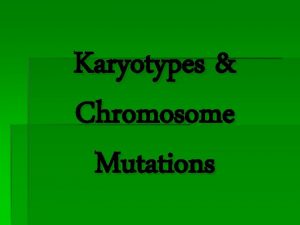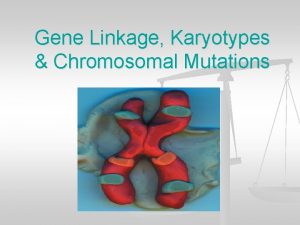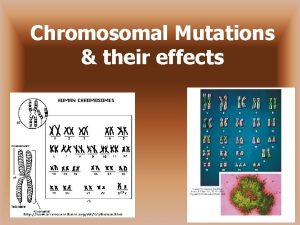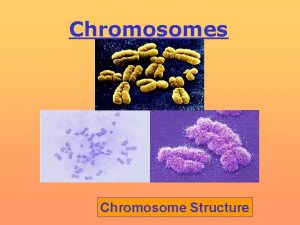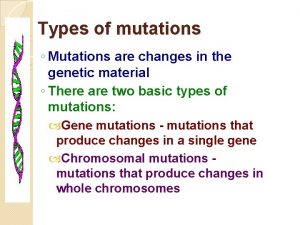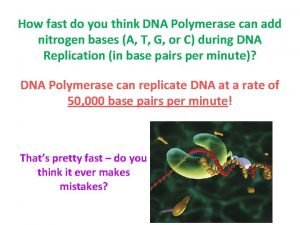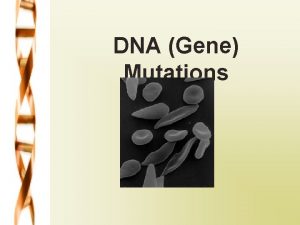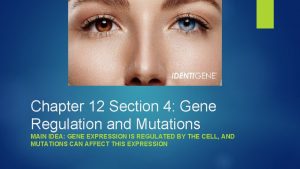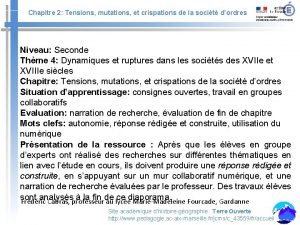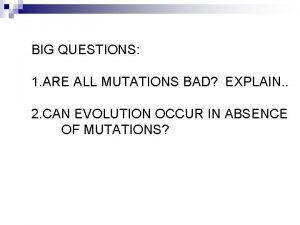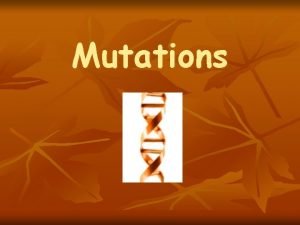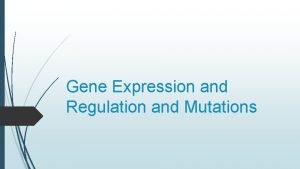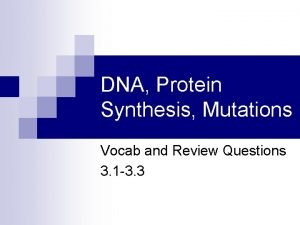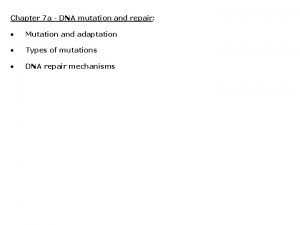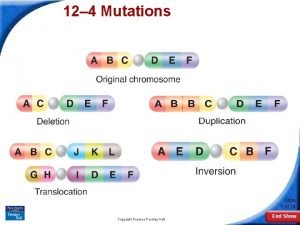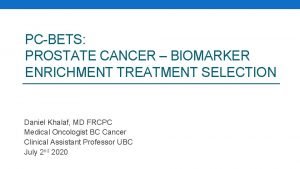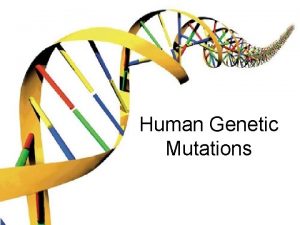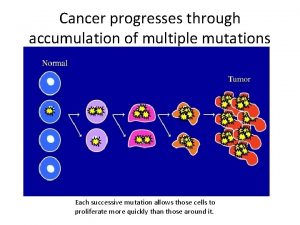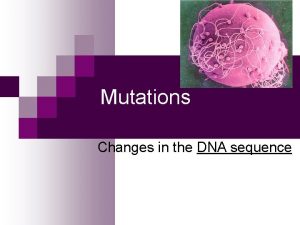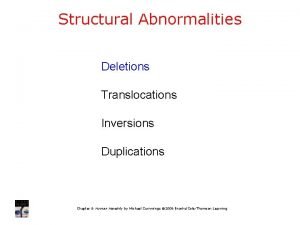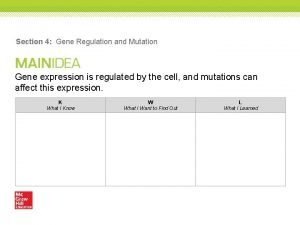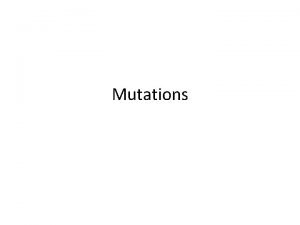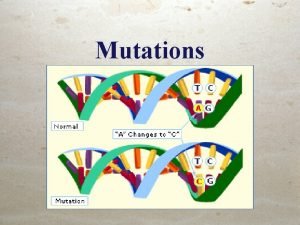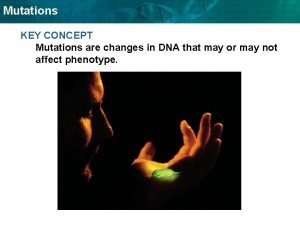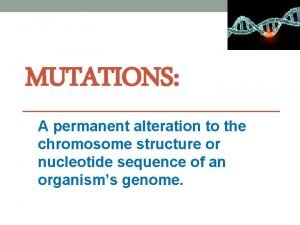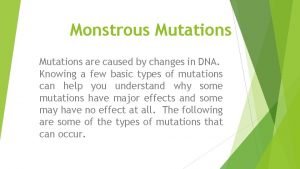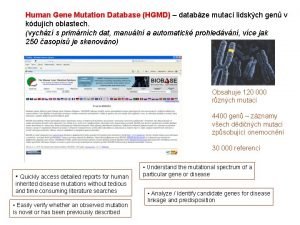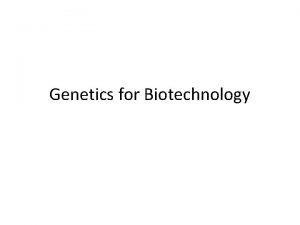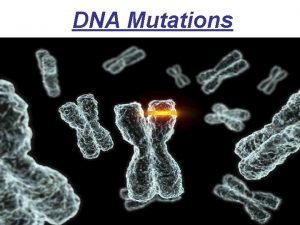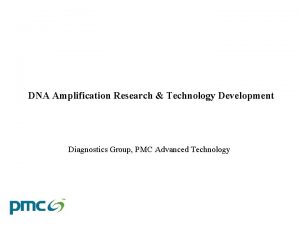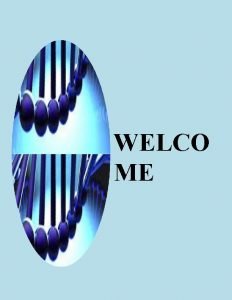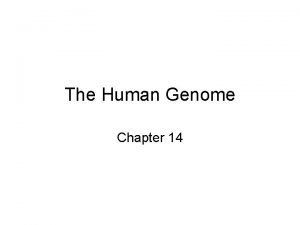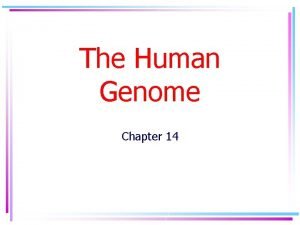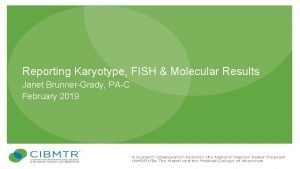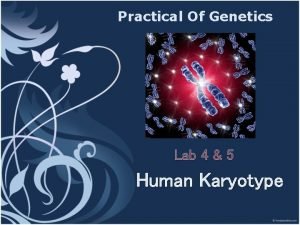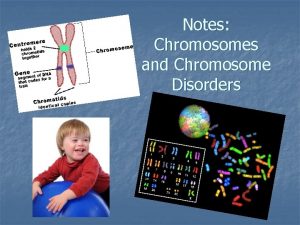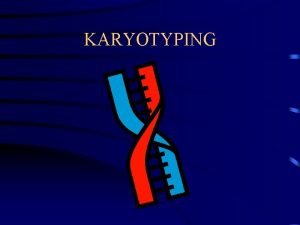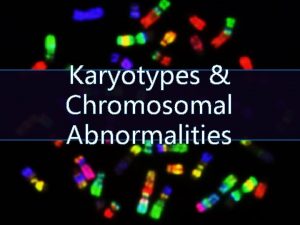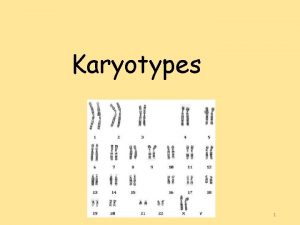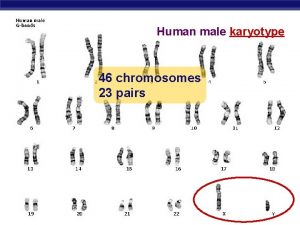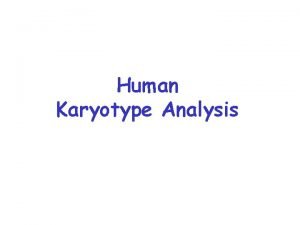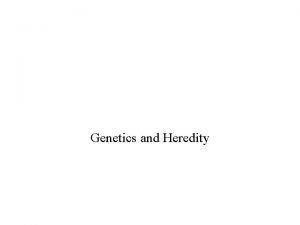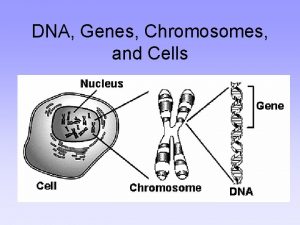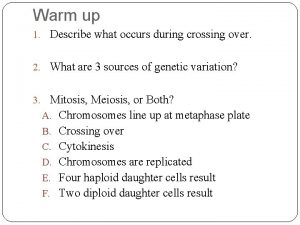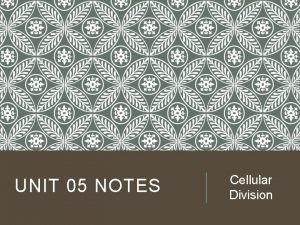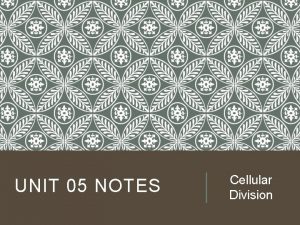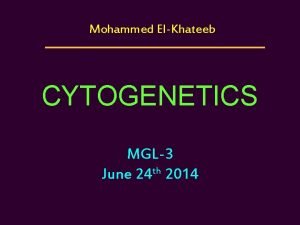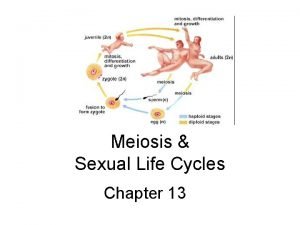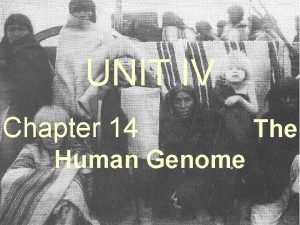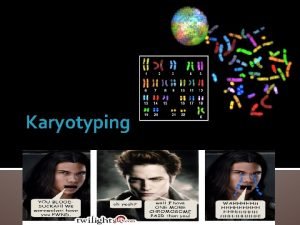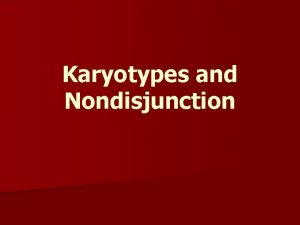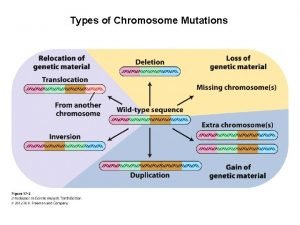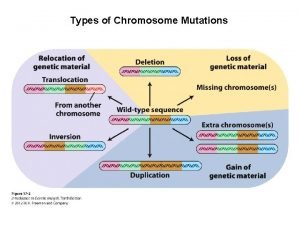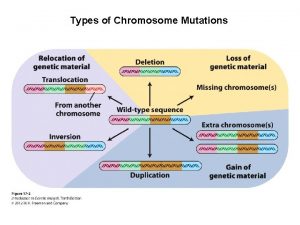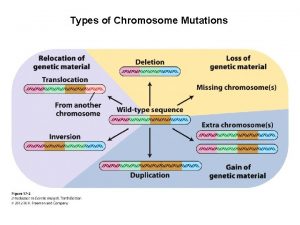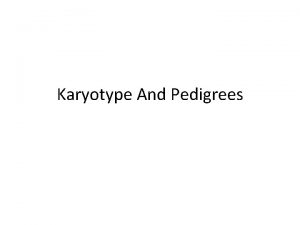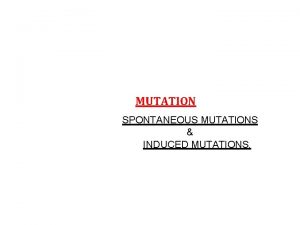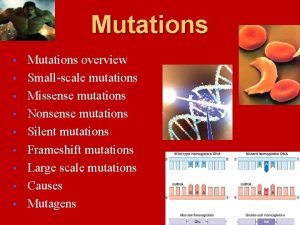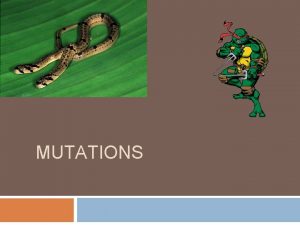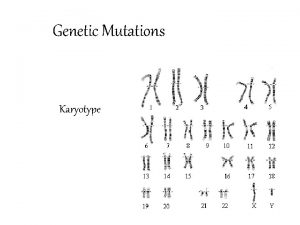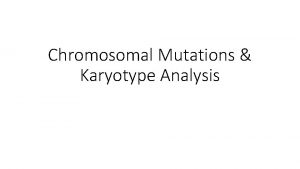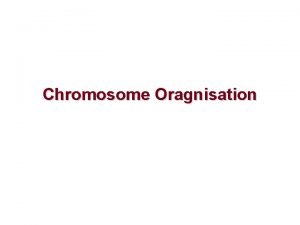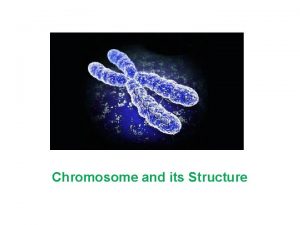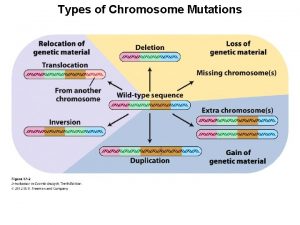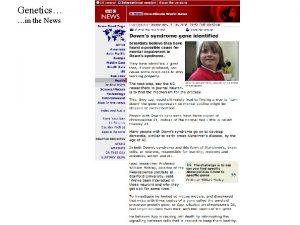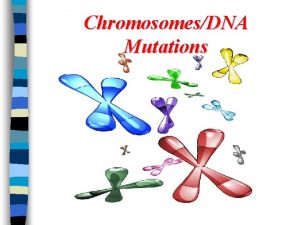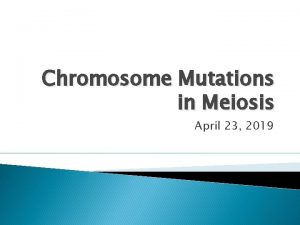Chromosome Mutations This image is called a karyotype































































- Slides: 63

Chromosome Mutations

This image is called a karyotype. It shows human chromosomes. Is this a girl or boy?

Types of Chromosome Mutations 1. Deletion: Occurs when a piece of chromosome breaks off, resulting in the loss of some genes. Ex: “cri du chat” syndrome is a deletion in the fifth largest chromosome. http: //www. youtube. com/watch? v=No. Nj 6 Ilqr. DY&safe=active

2. Duplication: (Addition) This is when a piece of chromosome breaks off and attaches to a homologous chromosome. The homologous chromosome will have some genes repeated. Ex: fragile X syndrome in males (there are 700 repeats) http: //www. youtube. com/watch? v=9_PEW 6 oc SNs&safe=active

3. Inversion: This occurs when a piece of chromosome is rotated and thus reverses the order of the genes in that segment. • Some genes participate in a common function. If these genes are separated by an inversion, they may not be able to function properly. Ex: This is believed to be the cause of some forms of autism. http: //www. youtube. com/watc h? v=j. WKLK 4 Fhb. CA&safe=active

4. Translocation: This is the transfer of a part of a chromosome to a non-homologous chromosome. Ex: Some forms of cancer such as leukemia and some forms of Down’s syndrome. http: //www. youtube. co m/watch? v=e. UZYACO 236 c&safe=active


5. Nondisjunction: This is the addition or loss of a whole chromosome and occurs during meiosis. • In this case homologous chromosomes or sister chromatids stay together. There are two types: 1. Trisomy 2. Monosomy

Trisomy - a cell has one extra chromosome. Ex: Down’s syndrome (trisomy 21) and Klinefelters syndrome (XYY). Monsomy - a cell is missing one chromosome. Monosomy is usually lethal. Why? (Because the cell lacks genetic material) Ex: Turner’s syndrome (XO) http: //www. youtube. com/w atch? v=EA 0 qxh. R 2 o. Ok&safe =active

6. Polyploidy: The condition that results in an organism having an extra set of chromosomes. • This occurs when a nucleus does not undergo the second meiotic division. • The gametes become 2 n instead of n. • The zygote becomes 3 n. This is common in plants but lethal in animals.

Human Genetic Diseases • There are three primary ways that the error can be inherited (passed from generation to generation). 1. Sex-linked inheritance 2. Dominant inheritance (includes codominant and incomplete dominance) 3. Recessive inheritance

Sex-Linked Disorders • Occurs due to errors in chromosome pair 23 (the sex chromosomes). • These genetic diseases occur only in males. • Since males have an XY sex chromosome any problems with the X chromosome causes a genetic disease • In females, which have XX chromosome any issue with an X chromosome is hidden by the other X. • Females can be carriers for the genetic disease, but not develop the disease themselves

Examples of sex-linked genetic diseases a. hemophilia--a disease in which the blood has less than 1% of the normal clotting factor.

b. Muscular Dystrophy: There is slow but progressive degeneration of muscle fibers. • In Duchenne’s muscular dystrophy, individuals are unable to walk by age 12 and normally die in their teenage years through a chest infection or heart failure. Usually below average intelligence.

c. color-blindness. In red-green colorblindness (The most common form) reds and greens are seen as gray.

Recessive Inheritance • Both parents must have the defective gene in order for the disease to be seen. • The parents usually don't have the disease, but carry the defective gene.

Autosomal Recessive Genetic Diseases a. Cystic Fibrosis- a disease that affects various glands, such as mucus, salivary and sweat glands. • • • It is diagnosed by the sweat test. Over-active mucus glands give these people chronic respiratory problems. Death usually occurs in early twenties unless treated with lung transplants.

b. phenylketonuria (PKU)-a disease of metabolism in which the child cannot break down phenylalanine (an amino acid) • To control the effects of the disease they must avoid this amino acid in their diet. • Since phenylalanine is in aspartame(Nutra. Sweet), warning labels appear on soft drinks which are sweetened with this product. • If ignored, they can become severely mentally handicapped within months. Infants are routinely tested for PKU.

c. Tay-Sachs disease -a recessive genetic disease in which the child cannot metabolize a certain lipid (fat). • These lipids surround the CNS and prevent the brain from expanding. • They become blind and mentally handicapped. Death occurs in early childhood.

d. Albinism – They lack the enzyme necessary to make the pigment melanin. Eye, skin and hair have no color

Dominant Inheritance • One bad gene from either parent will cause the genetic disease. • Since only one bad gene causes the disease, if either parent has the disease the chance of the child inheriting the bad gene and developing the disease is 50% with each conception. • An example of a dominant genetic disease is Huntington's Disease.

a. Huntington's Disease - involuntary twitching Caused by a duplication mutation. • Huntington's usually has its onset when a person is in their forties. • It is characterized by a deterioration of parts of the central nervous system which affect both muscle control and behavior.

b. Progeria - rare disorder that results in accelerated aging. Caused by a gene mutation https: //www. youtube. com/watch? v=Nazumb 80 lsc

Incomplete Dominance Inheritance • Familial hypercholesterolemia (FH): A disease that causes high cholesterol. • People with this disease do NOT have as many LDL receptors on their cells, which means less LDL’s can be taken up by cells and build up in the artery walls leading to atherosclerosis (plaque build-up). • Heterozygous individuals often have heart attacks by age 35. • Homozygous recessive individuals have heart attacks by the age of two.

Codominant Inheritance (Must have two dominant alleles) • Sickle-cell disease- a blood disease in which some of their hemoglobin is abnormal • The sickle-shaped red blood cells clog the capillaries so that cells cannot get needed oxygen and nutrition. • Sickle-cell disease is treated by blood transfusions, pain killers and chemicals which increase the oxygen carrying capacity of the blood. http: //www. pbslearningmedia. org/resource/tdc 02. sci. life. ge n. mutationstory/a-mutation-story/

Chromosomal Disorders a. Klinefelter's Syndrome--occurs only in males when the male child receives an XXY sex chromosome combination instead of the normal XY. • • Klinefelter's affects sexual development (small testicles, do not produce normal amounts of testosterone) Klinefelter's boys have an incomplete puberty and a childlike appearance. They will not grow facial hair and will show some breast development. Klinefelter's is often accompanied by mental deficiency or mental retardation.


b. Jacobs syndrome--a form of trisomy 23 that occurs only in males. • In the past, XYY males were called "super males, " because they are abnormally tall, abnormally strong and abnormally aggressive.

c. Triple X syndrome -- These individuals are called metafemales. They have limited fertility but are otherwise normal.

d. Turner's Syndrome - occurs when the female child receives only a single X sex chromosome instead of the normal XX combination (monosomy 23). • Turner's girls have retarded sexual development, are sterile, have a webbed neck, and have very specific mental deficiencies involving visual recognition and spacial arrangements. There are external genitalia but no ovaries. There are heart, kidney and skeletal defects.

e. Down's Syndrome--a form of trisomy in which there is an extra chromosome at 21. • Down's effects either sex, and is usually accompanied by moderate to severe mental retardation. • They often have heart defects and are susceptible to infections.

Detecting Genetic Disorders 1. Amniocentesis • A sample of the amniotic fluid can be removed using a needle and examined for genetic abnormalities. • The cells are placed in a nutrient-rich medium and allowed to multiply for a few weeks to provide a large enough sample to be karyotyped • This procedure can not be done prior to the fourteenth week due to risk to the fetus. http: //www. cbsnews. com/news/detectinggenetic-disorders-sooner/


2. Fetoscopy • An endoscope is inserted into a small incision in the mother’s abdomen. • The endoscope has a camera to view the fetus and can also be used to take samples or perform operations. • Used to remove excess fluid around the brain, provide fetal blood transfusions and collect blood samples for karyotyping or to determine blood type.


3. CVS (chorionic villi sampling) • This procedure can be done as early as the ninth week of pregnancy. • Cells are removed from chorion. These cells are derived from the fetus. • The cells are grown in a medium and later karyotyped


4. Karyotyping • A cell undergoing mitosis is photographed. The photograph is enlarged and the chromosomes are cut out and arranged in pairs to examine any abnormalities.

5. DNA Probe: • Radioactive synthetic DNA is mixed with DNA from a suspected carrier. • The DNA is complementary to the known mutated gene and will pair with the human gene if it is defective. • If the person is a carrier then the human DNA will become radioactive. • Ex: sickle cell anemia, cystic fibrosis, muscular dystrophy, hemophilia, phenyketonuria.


6. Genetic Markers • This is any characteristic that provides information about an organism’s genome • A known DNA sequence that lies close to the disease causing gene is called a linked marker. It does not affect the gene but is always found near it. Ex: Huntington’s Disease. • A gene-specific marker is a sequence of DNA that is part of the gene itself. These markers always indicate the presence of the gene causing the disorder.


Treatments of Genetic Disorders 1. Screening and Prevention • There are routine blood tests done at birth to determine the presence of genetic disorders. (Ex: phenylketonuria) 2. Surgery • Cleft palates can be fixed using reconstructive surgery

3. Environmental Control • This can be done to minimize the effects of the symptoms. • Ex: albinos lack the pigment melanism and should limit their exposure to direct sunlight.

4. Gene Therapy • Normal or modified genes are transferred to the defective cell and enable it to properly produce the original defective protein. • This is still experimental • Ex: Spina bifida can be treated by inserting a tube leading from the brain to the digestive tract so that fluid can be released and prevent mental retardation.


Genetic Counseling • Genetic counselors study the medical histories of couples and their families and advise them of the frequency of disorders and risk factors associated with their particular case. They will normally construct a pedigree of their family history. • Couple are considered to be of high risk if they already have a child with a genetic disorder, a family history of genetic disease and if the woman is over the age of 35.

Question: What are the ethical considerations of genetic engineering and genetic counseling?

What is Genetic Counselling? https: //www. youtube. com/watch? v=Pfm. JYQRL 27 k Genetic Counseling raise ethical issues https: //www. youtube. com/watch? v=8 e. R 4 Xd. JSmqc Would you find out what’s in your genes? http: //www. cnbc. com/2015/12/10/unlocking-mygenome-was-it-worth-it. html

Human Genetics and Pedigree Analysis Pedigrees: Family Trees • One of the central tasks of the human geneticist • Pedigree analysis is the construction of family trees • A pedigree is used to trace inheritance of a trait over several generations.

Three primary patterns of inheritance: 1. autosomal recessive 2. autosomal dominant 3. sex-linked (X-chromosomal)

Symbols used in pedigree charts:


Autosomal Recessive Pedigree • Recessive: If neither parent has the characteristic phenotype (disease) displayed by the child, the trait is recessive. • Autosomal: Gene is on one of the autosomes (Chromosomes 1 -22). Male and female offspring equally likely to inherit trait.

A typical pedigree:

Worksheet: The Perils of Inbreeding: A Case Study in Saudi Arabia

Autosomal Dominant Pedigree • Dominant: Affected individuals can appear in every generation • Autosomal: Gene is on one of the autosomes (Chromosomes 1 -22). Male and female offspring equally likely to inherit trait. • A trait that appears in successive generations is normally due to a dominant allele.


Sex-Linked Pedigree • X-linked: The trait is preferentially seen in males, who are hemozygous. Females are heterozygous "carriers" • Most X-linked traits are recessive. • Ex: Inheritance of red-green color blindness


Sickle Cell Anemia • http: //www. youtube. com/watch? v=9 Upw. V 1 tdxcs

• http: //www. youtube. com/watch? v=S 6 o 2 -Bg. Kg. Oo – Huntington’s Disease

Practice Multiple Choice
 Karyotype mutations
Karyotype mutations Chromosomal mutation
Chromosomal mutation Karyotype mutations
Karyotype mutations How to read chromosome
How to read chromosome Types of mutations
Types of mutations What are some neutral mutations
What are some neutral mutations Cytoplasm structure
Cytoplasm structure What causes mutation
What causes mutation Chapter 14 lesson 4 mutations
Chapter 14 lesson 4 mutations Section 4 gene regulation and mutations
Section 4 gene regulation and mutations Tensions mutations et crispations de la société d'ordres
Tensions mutations et crispations de la société d'ordres Inversion dna
Inversion dna Beneficial mutations examples
Beneficial mutations examples Missense mutation in sickle cell anemia
Missense mutation in sickle cell anemia Types of mutations
Types of mutations Protein synthesis and mutations
Protein synthesis and mutations Protein synthesis and mutations
Protein synthesis and mutations Types of substitution mutations
Types of substitution mutations 12-4 mutations
12-4 mutations Cancer mutations
Cancer mutations Tautomeric shift mutation
Tautomeric shift mutation Cancer mutations
Cancer mutations Cancer mutations
Cancer mutations Dna types of mutations
Dna types of mutations Reverse mutation
Reverse mutation Non reciprocal translocation
Non reciprocal translocation Section 4 gene regulation and mutations
Section 4 gene regulation and mutations Chromosomal mutation
Chromosomal mutation Mutations are any mistake or change in the...
Mutations are any mistake or change in the... Gene mutations
Gene mutations A permanent alteration that changes a dna sequence
A permanent alteration that changes a dna sequence Monstrous mutations
Monstrous mutations Point mutations
Point mutations Gene mutations
Gene mutations Somatic mutations
Somatic mutations Central dogma
Central dogma 4 types of mutations
4 types of mutations Mutations in dna
Mutations in dna Jacob syndrome
Jacob syndrome Whats a karyotype
Whats a karyotype Color blindness karyotype
Color blindness karyotype Sickle cell karyotype
Sickle cell karyotype Fish karyotype
Fish karyotype Human karyotype
Human karyotype What is characteristics
What is characteristics Anaphase
Anaphase Karyotype of klinefelter syndrome
Karyotype of klinefelter syndrome Female with klinefelter syndrome karyotype
Female with klinefelter syndrome karyotype Whats a karyotype
Whats a karyotype Aneuploidy
Aneuploidy Karyotype
Karyotype 46 chromosomes
46 chromosomes Karyotypes of klinefelter syndrome
Karyotypes of klinefelter syndrome How do you know if a karyotype is male or female
How do you know if a karyotype is male or female Sickle cell karyotype
Sickle cell karyotype Language
Language Karyotype
Karyotype 23 chromosome pairs
23 chromosome pairs Karyotype
Karyotype How to read chromosome
How to read chromosome Karyotype human female
Karyotype human female Karyotype
Karyotype Klienfelters syndrome have karyotype
Klienfelters syndrome have karyotype Nondisjunction karyotype
Nondisjunction karyotype
